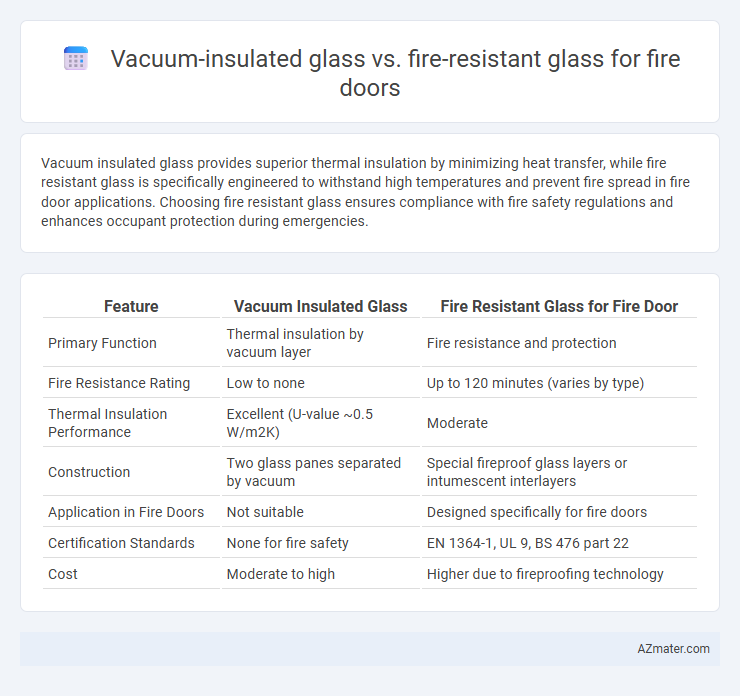Vacuum insulated glass provides superior thermal insulation by minimizing heat transfer, while fire resistant glass is specifically engineered to withstand high temperatures and prevent fire spread in fire door applications. Choosing fire resistant glass ensures compliance with fire safety regulations and enhances occupant protection during emergencies.
Table of Comparison
| Feature | Vacuum Insulated Glass | Fire Resistant Glass for Fire Door |
|---|---|---|
| Primary Function | Thermal insulation by vacuum layer | Fire resistance and protection |
| Fire Resistance Rating | Low to none | Up to 120 minutes (varies by type) |
| Thermal Insulation Performance | Excellent (U-value ~0.5 W/m2K) | Moderate |
| Construction | Two glass panes separated by vacuum | Special fireproof glass layers or intumescent interlayers |
| Application in Fire Doors | Not suitable | Designed specifically for fire doors |
| Certification Standards | None for fire safety | EN 1364-1, UL 9, BS 476 part 22 |
| Cost | Moderate to high | Higher due to fireproofing technology |
Introduction to Fire Door Glazing Technologies
Fire door glazing technologies prioritize safety and performance by incorporating specialized glass types such as vacuum insulated glass (VIG) and fire resistant glass. Vacuum insulated glass offers thermal insulation and energy efficiency but has limited fire resistance capabilities compared to fire resistant glass, which is specifically engineered to withstand high temperatures and prevent flame spread. Selecting the appropriate glazing technology depends on balancing thermal performance with stringent fire safety standards in fire door applications.
What Is Vacuum Insulated Glass?
Vacuum insulated glass (VIG) consists of two glass panes separated by a vacuum layer that significantly reduces heat transfer, providing superior thermal insulation for fire doors. This technology enhances energy efficiency and soundproofing while maintaining visibility, making it suitable for modern fire-rated door systems. Unlike fire resistant glass, which focuses primarily on heat and flame resistance, vacuum insulated glass optimizes thermal performance without compromising fire safety features.
What Is Fire Resistant Glass?
Fire resistant glass is specially engineered to withstand high temperatures and prevent the spread of flames and smoke, making it ideal for fire doors. Vacuum insulated glass primarily enhances thermal insulation and energy efficiency but lacks the necessary fire-resistance rating for safety compliance in fire doors. Fire resistant glass typically contains multiple layers, including intumescent interlayers that expand under heat to provide a protective barrier, ensuring structural integrity during a fire event.
Thermal Performance: Vacuum Insulated vs Fire Resistant Glass
Vacuum insulated glass offers superior thermal insulation by minimizing heat transfer through its vacuum layer, maintaining energy efficiency and reducing condensation. Fire resistant glass is engineered to withstand high temperatures and prevent flame penetration while providing moderate thermal performance under fire exposure. For fire doors, combining fire resistant glass with enhanced thermal insulation properties can optimize both safety and energy efficiency.
Fire Safety Standards and Compliance
Fire resistant glass for fire doors must comply with stringent fire safety standards such as UL 10C, BS 476, and EN 13501, ensuring performance under high temperatures and preventing fire spread. Vacuum insulated glass typically focuses on thermal insulation and soundproofing, lacking certification for fire resistance, making it unsuitable for fire door applications requiring compliance with fire safety regulations. Choosing fire resistant glass guarantees adherence to legal fire safety requirements and enhances occupant protection during emergencies.
Durability and Longevity Comparison
Vacuum insulated glass offers excellent thermal insulation but generally has moderate fire resistance and may degrade faster under prolonged high temperatures compared to fire resistant glass. Fire resistant glass is specifically engineered with layers that withstand extreme heat and maintain structural integrity during fire exposure, resulting in superior durability and longer lifespan in fire door applications. The specialized composition of fire resistant glass ensures consistent performance under fire conditions, making it the more reliable choice for long-term fire protection.
Energy Efficiency Considerations
Vacuum insulated glass offers superior thermal insulation by minimizing heat transfer through its vacuum layer, significantly enhancing energy efficiency in fire doors. Fire resistant glass, while designed primarily to withstand high temperatures and prevent flame spread, typically has lower insulating properties compared to vacuum insulated glass. Selecting glass combining fire resistance with vacuum insulation technology can optimize both energy efficiency and safety in fire door applications.
Cost Analysis: Initial and Lifetime Expenses
Vacuum insulated glass for fire doors involves higher initial costs due to advanced manufacturing and specialized vacuum sealing techniques but offers superior thermal insulation that can reduce energy expenses over its lifetime. Fire resistant glass typically has lower upfront costs and provides essential fire protection, but may lead to higher maintenance or replacement expenses depending on door usage and compliance requirements. Evaluating total cost of ownership requires balancing the upfront investment against energy savings and durability benefits specific to each glass type in fire door applications.
Applications and Best Use Cases
Vacuum insulated glass offers superior thermal insulation and soundproofing, making it ideal for fire doors in commercial buildings where energy efficiency and noise reduction are priorities. Fire resistant glass is designed to withstand high temperatures and prevent fire spread, making it essential for fire doors in emergency exit routes, hospitals, and industrial facilities requiring stringent fire safety measures. Choosing between these depends on balancing fire protection standards with insulation needs specific to the building's function and safety regulations.
Choosing the Right Glass for Fire Doors
Vacuum insulated glass offers superior thermal insulation and energy efficiency but lacks the fire resistance necessary for fire door applications, whereas fire resistant glass is specifically engineered to withstand high temperatures and prevent fire spread. Selecting the right glass for fire doors requires prioritizing certified fire resistance ratings such as BS 476 or UL 9 to ensure compliance with safety standards. Fire resistant glass typically incorporates intumescent interlayers or tempered layers that maintain integrity under fire exposure, making it essential for effective fire protection and occupant safety.

Infographic: Vacuum insulated glass vs Fire resistant glass for Fire door
 azmater.com
azmater.com